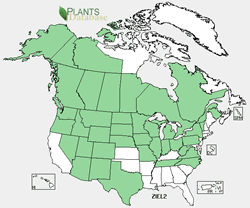Plant of the Week
 Zigadenus elegans range map. USDA PLANTS Database.
Zigadenus elegans range map. USDA PLANTS Database.
 The green glands (yellow in some species) at the base of the petals are a good diagnostic characteristic to identify deathcamus (Zigadenus species). Photo by Charlie McDonald.
The green glands (yellow in some species) at the base of the petals are a good diagnostic characteristic to identify deathcamus (Zigadenus species). Photo by Charlie McDonald.
 These mountain deathcamus plants are growing in a meadow on the San Juan National Forest south of Pagosa Springs, Colorado. This meadow adjacent to U.S. Highway 84 had a good assortment of wildflowers when visited in late May. Photo by Charlie McDonald.
These mountain deathcamus plants are growing in a meadow on the San Juan National Forest south of Pagosa Springs, Colorado. This meadow adjacent to U.S. Highway 84 had a good assortment of wildflowers when visited in late May. Photo by Charlie McDonald.
Mountain Deathcamas (Zigadenus elegans)
By Charlie McDonald
“Pretty wildflower? Yes! Deadly poisonous plant? Yes!” All fresh parts of deathcamas (leaves, bulbs, flowers) are poisonous. Dried parts (especially seeds and capsules) are even more potent. Ingestion by humans can cause severe illness and occasionally death, even for adults. Livestock poisoning from deathcamas is a serious problem in some western rangelands.
Almost every state in the United States has at least one species of deathcamas in its flora. All of the species are lily-like plants with linear parallel-veined leaves and flower parts in multiples of three. The flowers are usually whitish or cream-colored and are arranged in terminal clusters. The petals usually have one or two, yellow to green basal nectar glands. Mountain deathcamas (Zigadenus elegans) is one of the more wide-ranging deathcamas species. It is found throughout most of the west and in the northeast. Plants in the east tend to have larger flower clusters and are larger plants overall than those in the west. The eastern plants are identified as variety glaucus in some books.
The greatest potential for deathcamas poisoning comes where deathcamas and common camus (Camassia quamash) grow together. The bulbs of common camus are edible and were a staple food for some Native American tribes of the Pacific Northwest. They are still eaten to some extent. Common camus and deathcamas look quite different when flowering, but the bulbs are dug in the fall when the plants are dormant and could be confused. Deathcamas bulbs can also be confused with wild onion bulbs.
Collecting wild plants for food can be a fun activity, but plants like deathcamas provide a cautionary note. Always be sure you know exactly what you are collecting and what other similar poisonous plants might grow in the same area. Always know what part of the plant is edible. For example, many plants with edible fruits have poisonous leaves. Always know preparation techniques. Some edible plants require special preparation to remove or neutralize toxic substances. Never trust the wildlife. Just because birds or bears can eat a wild plant, does not mean it is safe for humans. Finally, if in doubt just do not eat wild plants.

